9 Best AI Reporting Tools in 2025
Looking for an AI reporting tool to turn complex data into clear, actionable insights—all in one place? But don’t have time to sift through endless options?
We’ve got you covered.
To make your search easier, we break down the key differences between the 9 best AI reporting tools that can make your decision-making faster in 2025.

Feb 20 2025●10 min read
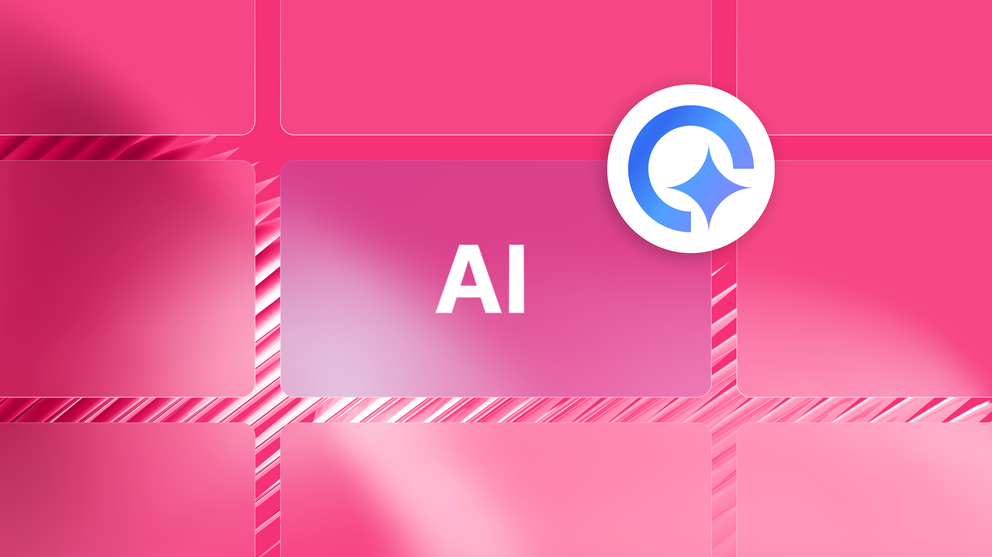
We talked to experts from agencies, small businesses and big in-house teams. They told us what they’re looking for in an AI reporting tool:
✅ Reliable integrations — Bring all your data from all your channels into one space.
✅ Clean data — Consolidate and prepare data for AI reporting.
✅ Performance monitoring — Get a clear view of performance, both for your clients and your internal team.
✅ Actionable AI insights — Share clear, actionable recommendations, not basic observations.
✅ Customizable reports — Easily repurpose any report for a new client with custom branding and new KPIs that align with their business goals.
✅ Report automation — Set up reporting flows with minimal input from your side.
9 Best AI Reporting Tools in 2025
Here are the best AI reporting tools we’ll review in this article:
- Whatagraph
- Klipfolio
- NinjaCat
- Venngage
- Easy-Peasy.AI
- Piktochart
- Tableau
- Power BI
- Domo
We decided to divide these tools in 3 categories:
- The best AI reporting tools for marketers,
- The best AI report generators and,
- The best tools that use AI for reporting in large organizations.
Let’s begin.
Best AI Reporting Tools for Marketers
If you’re a marketer, you need a tool that helps you track campaign performance efficiently. Apart from stable data connectors, look for customizable visualizations, no-code data cleaning, and AI agents you can interact with in natural language.
1. Whatagraph
Best for: Medium to large marketing agencies with 10+ employees
Whatagraph is a marketing intelligence platform that simplifies reporting for agencies.
It connects, standardizes, and reports multi-source marketing data in one platform—delivering accurate insights and customizable reports that scale effortlessly.
Here’s how it works:
- Connect to your data sources and channels in a few clicks. Your data will flow in automatically.
- Organize and unify your data to prepare it for analysis. Create data blends, custom metrics, and dimensions—without writing a single line of code.
- Visualize your data using drag-and-drop widgets or ready-made report templates. Create white-labeled reports with custom logos, domains, and color schemes.
- Analyze your data by client, campaign, Account Manager, or more. Identify trends, compare performance, and get actionable insights for your agency and your clients. Use AI chatbot to cut through the KPI clutter and get high-quality AI summaries.
Share reports as live links, PDFs, Excel spreadsheets, or automated emails. You can also transfer your data to BigQuery and Looker Studio through Whatagraph.
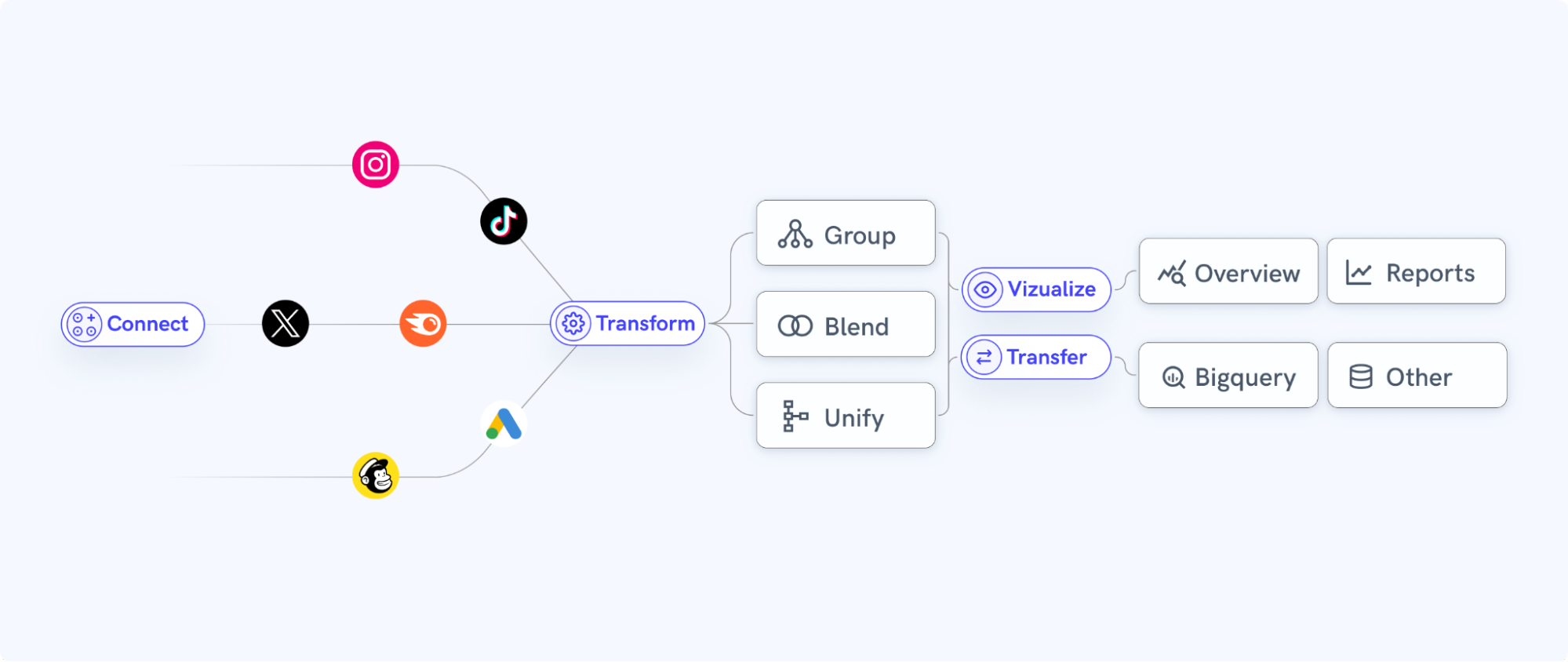
And whenever you have a question, you can reach out to our support team via live chat and we’ll respond to you within 1 minute.
All our pricing plans come with live chat and email support.
Plus, there’s a dedicated Customer Success Manager just for you.
But how does Whatagraph fit among the best AI tools for marketing reporting?
Let’s get started.
#1. Performance Monitoring
For example, let’s say you have 100s of scattered data points across different sources, campaigns, channels, and accounts.
Even if you connect all those sources with one tool, the problem is that actionable insights, trends, and patterns are hidden under a pile of data.
Thanks to recently launched Performance Monitoring, Whatagraph can help you get actionable insights from your data without breaking a sweat:
✅ Source groups: Group 100s of scattered data sources into a unified source group in seconds. This way, you can report on their aggregated metrics without creating custom formulas.
✅ Custom tags: Add custom tags to your data and filter it by client, business type, location, Account Manager, etc.
✅ Overviews: Create an internal dashboard of your clients’ accounts in one view and easily spot performance trends.
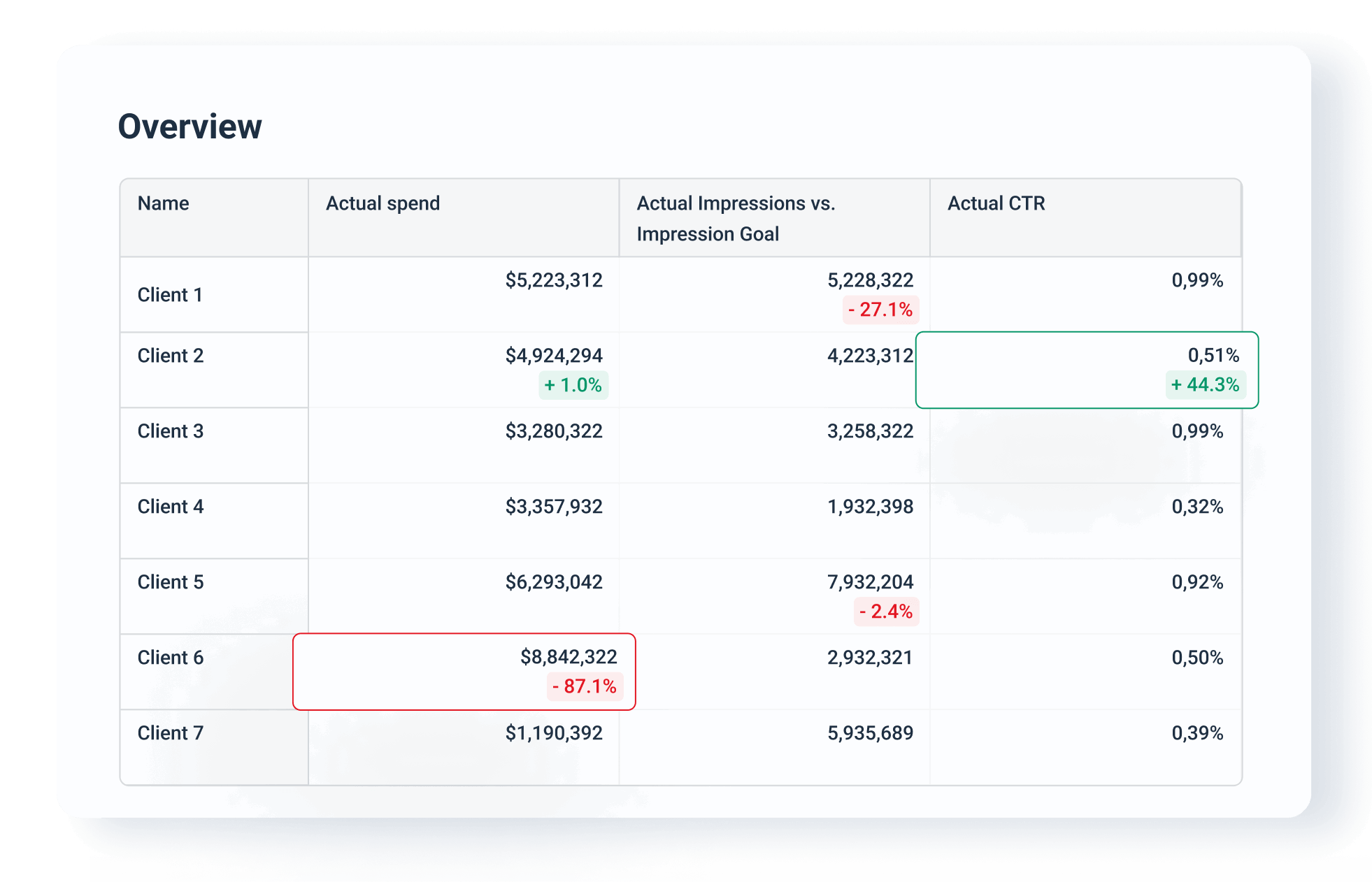
The Overview is especially useful for bigger marketing agencies, who can use it for:
- Unified view of their client portfolio
- Team performance tracking
- Faster, data-driven decision-making
#2. Actionable Insights and Summaries
A good AI reporting tool for agencies should be able to dive deep into clients’ data and return meaningful insights.
Whatagraph’s AI chatbot checks that box with flying colors.
And yet, Whatagraph’s incredibly simple and easy to use.
Anyone from your team—whether an Account Manager or an intern—can easily log into Whatagraph and start using it immediately.
The best thing is that you can jump straight into AI insights without even creating a report.
Our AI Chatbot can answer any question about any of your connected data sources.
This includes blended sources and source groups.
Simply click on the blue chatbot icon in the bottom right corner and type a question or use one of the suggested prompts.
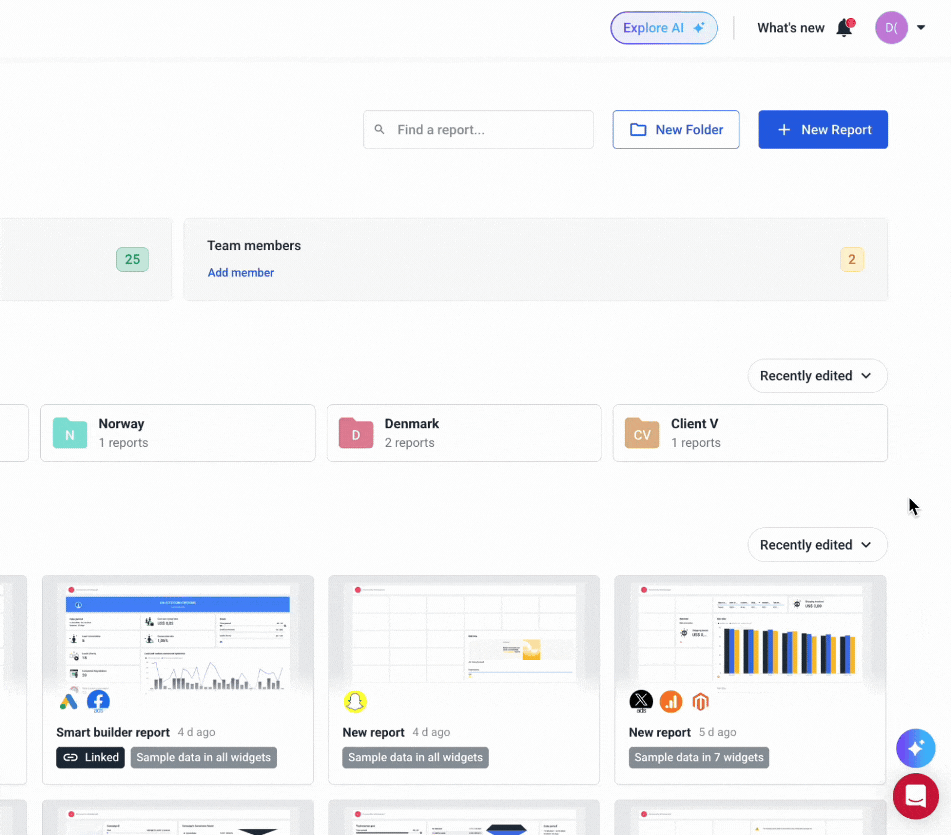
In both cases, you can select the source or sources and date range that you want the AI agent to analyze.
Then, you can copy the answer and paste it directly into any conversation you might be having with your client.
You can ask very specific things about your marketing campaigns and get a very detailed answer with its own Key Insights:
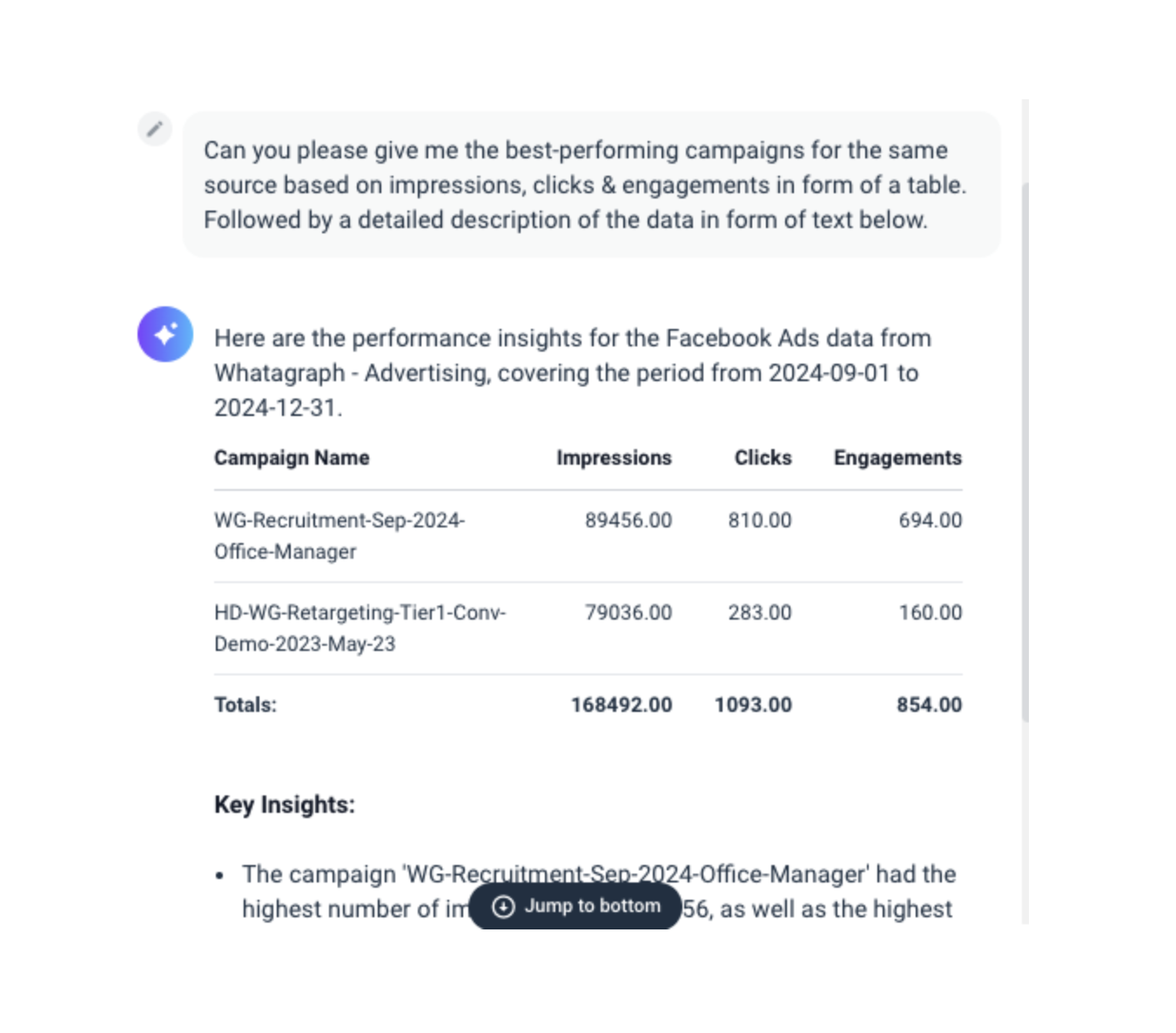
Our AI chatbot can also read the history, so if you don't like a part of the answer, you can ask it to make any adjustments.
Another quick way you can get valuable insights from your data is through AI Report Summaries.
Writing comments and insights manually takes some time.
Between deciding what to say and what angle to take… you end up with a few bullet points that took you 10 minutes to write.
With Whatagraph AI, creating a summary takes no longer than 10-15 seconds:
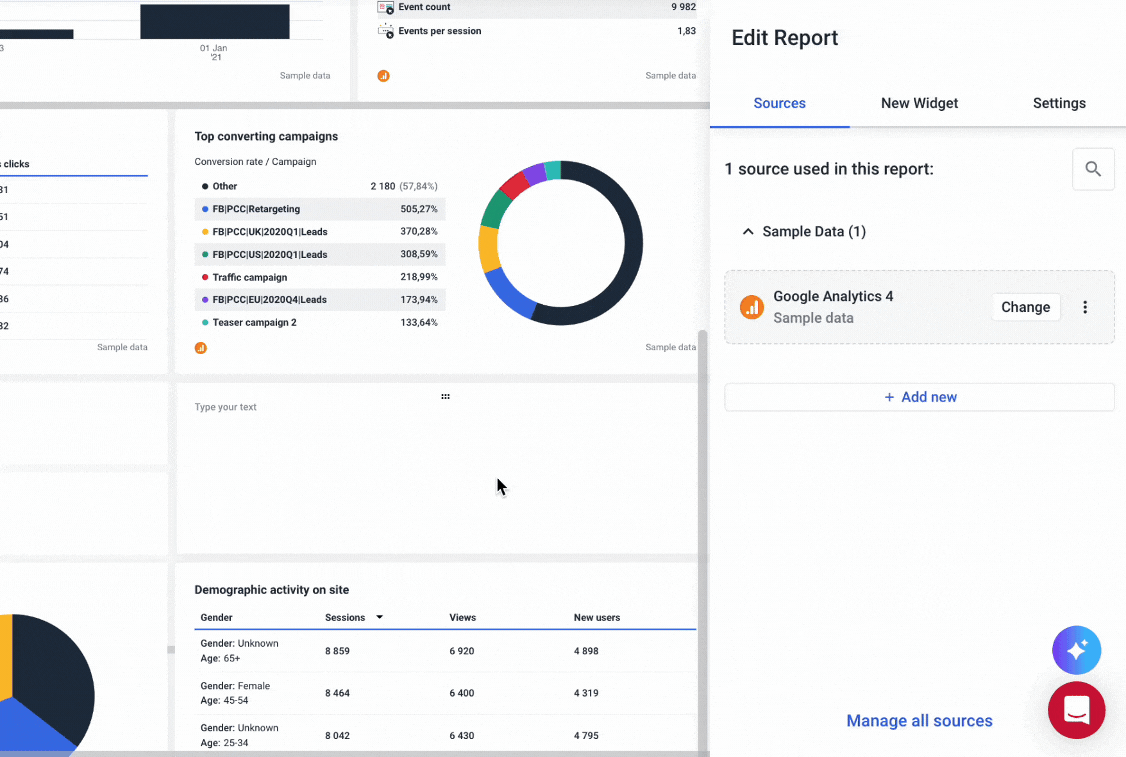
Then, you can edit the summary, include your own thoughts, and add it to a Text Widget.
#3. Reliable Integrations
The quality of your AI insights depends on the quality of your data.
Even AI-generated marketing reports are worthless if the underlying data keeps breaking or showing wrong numbers.
Looking at how some competitors struggle with data connectors, we decided to build platform stability and data accuracy into the foundation of Whatagraph.
How do we achieve that?
By building our data connectors ourselves!
Our integrations are fully managed, which means they’re more seamless, stable, and reliable than third-party connectors you can buy from different vendors.
For example, to connect your sources, you simply:
- Open Whatagraph, go to Data Sources and select the marketing platforms you need.
- Follow the on-screen instructions to provide the necessary credentials and connect each source.
- Once connected, Whatagraph will automatically pull in the latest data and update it automatically.
From there on, there’s nothing to update on re-connect on your part.
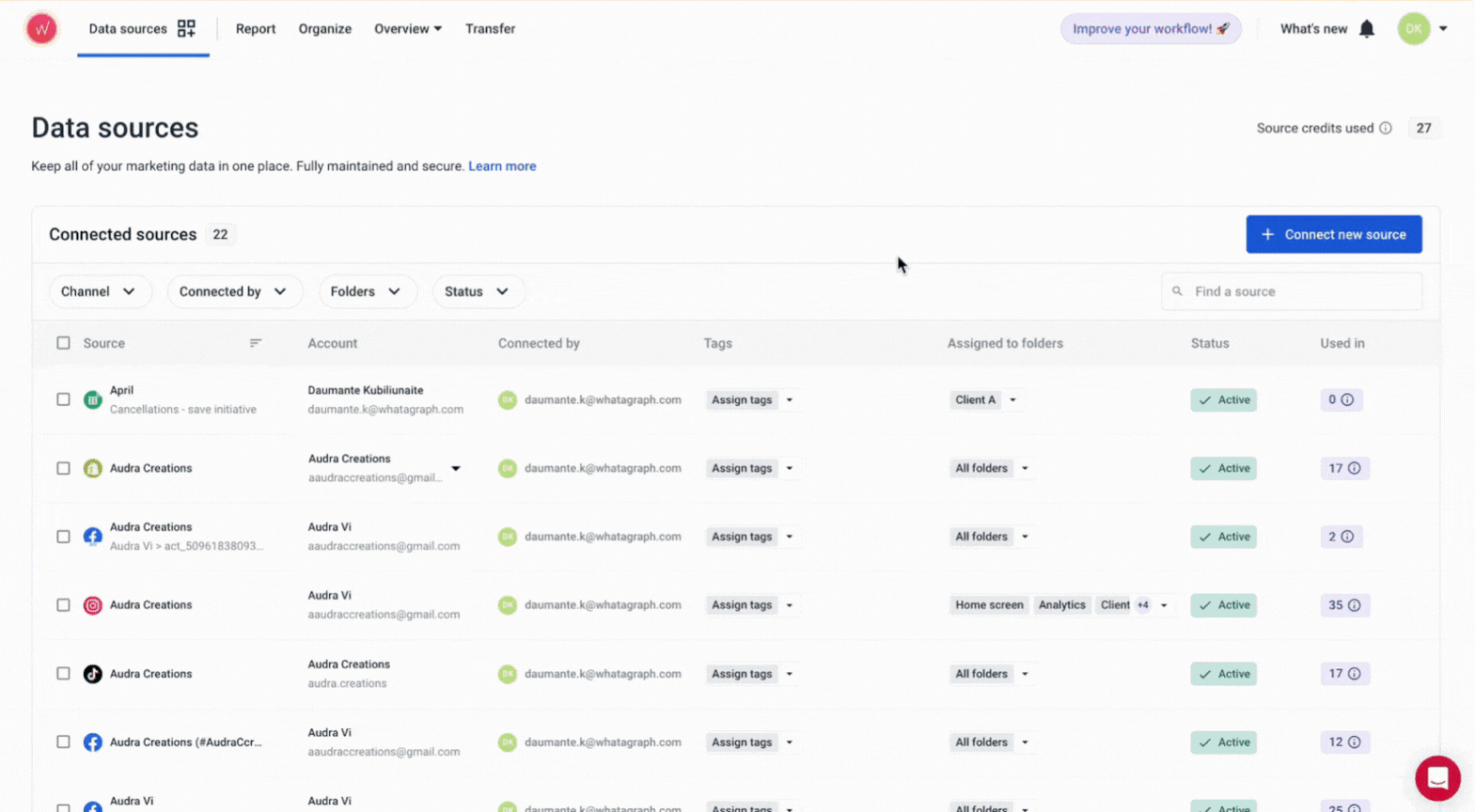
Our Product engineers regularly maintain them for fewer inconsistencies and network issues.
As far as the platform's speed is concerned, you can work with 10 sources and 100 widgets at the same time on Whatagraph without slowing down the platform.
Thanks to a recent update to Google Kubernetes Engine, even reports with heavy widgets, tabs, and charts take less than 10 seconds to load on Whatagraph.
And according to data from the past 6 months, Whatagraph has an average uptime of 99.95%.
We also have an emergency alert that will wake up all our Product engineers (even if it’s 3 am where they are) to quickly fix system outages, if there are any.
#4. Clean and Accurate Data
Ok, you’ve connected all your data sources with reliable integrations.
Your data is in one place, so you can easily analyze each channel’s performance.
With Whatagraph, you don’t even have to create a report to get insights — you can ask a question about any connected source in the AI chat right away.
But what if you need to analyze reach and conversions across several PPC platforms?
What if your client wants to know the total engagement from all their social media accounts?
If you‘ve ever tried to combine data from several sources manually, you know all the struggles:
❌ Metrics and dimensions have different names on different platforms.
❌ You can have missing data for the same time period, which causes errors in spreadsheet calculations.
❌ Different platforms name locations differently (Great Britain vs. GB vs. United Kingdom vs. UK, etc.)
❌ Even campaign names can be hard to tell from one another.
All this can give you headaches whenever you try to get actionable insights from your data.
Ok, but I have AI to tell me whatever I need to know.
Sure, you can try that, but even AI technology can’t tackle missing data, different metrics names between the platforms, anomalies in data, etc.
This is why you need to clean and consolidate data before exploring it with AI.
Whatagraph makes it easy to organize your scattered data and get actionable insights from it in minutes.
For example, you can:
- Blend data sources together: Great for combining different sources together into one unified data source for getting quicker insights and keeping your dashboard neat (no limits to how many sources you can blend).
- Create custom metrics: Unify and change the names of different metrics permanently in your report or create a new metric using a simple formula.
- Create custom dimensions: Unify names of different cross-channel dimensions and group data points from different sources.
All these features can help you prepare cross-channel data for AI reporting.
To conclude—AI insights are only as accurate as the underlying data.
Whatagraph helps you clean this data in a few minutes with zero coding.
#5. Flexible and Automated Reports
You can create your report or dashboard from scratch and structure it just as you want.
Still, having a template to start with saves a lot of time, especially if you need to report to several clients or stakeholders regularly.
Whatagraph has pre-made digital marketing report templates that you can customize for each client.
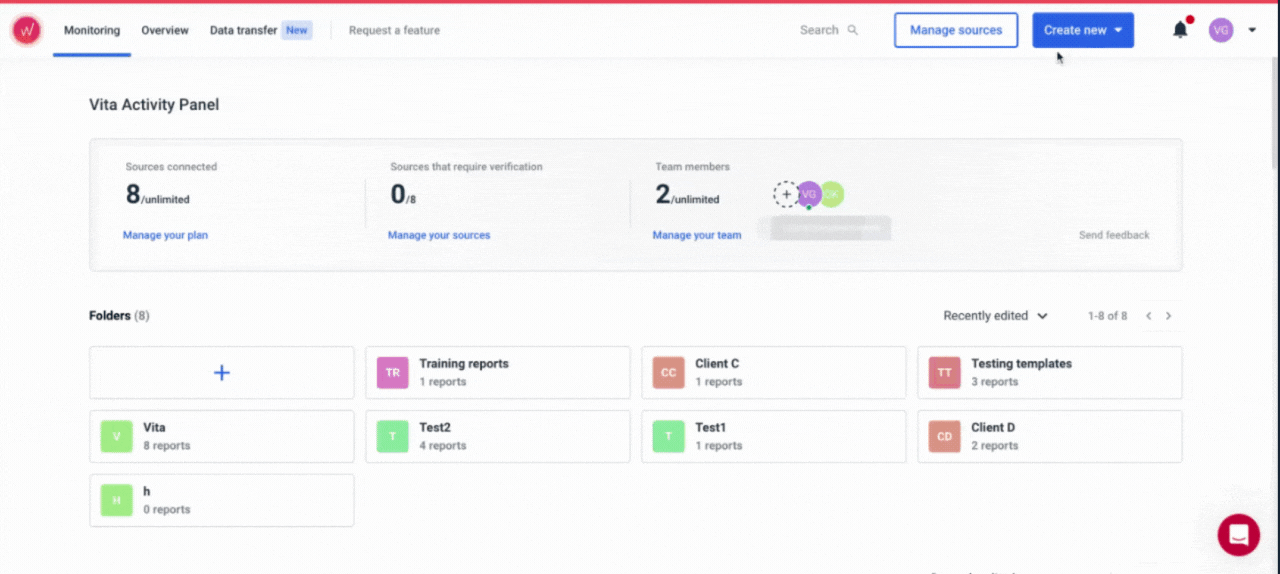
The template is your starting point. From there, you can quickly customize any report to a client's specifications.
Once you find a template that’s the closest match to your needs, you can start tailoring it:
✅ Connect more data sources: You can load a template with just one source connected, but now you can add other sources that hold your campaign data. You can also remove the sources you don’t need to keep your report uncluttered.
✅ Customize metrics and widgets: Check out the metrics already included in the template and decide if you need to remove some of them so the clients can really focus just on the important ones.
✅ Choose the appropriate visuals: Whatagraph has different chart options, such as line charts, bar graphs, funnels, and pie charts. If your client prefers a bar chart to a pie chart for a specific metric — a piece of cake. Pick the bar chart widget and select the metrics and dimensions you want to see.
✅ Arrange the widgets for easy understanding: Always put the key metrics, like Organic Reach or Reactions, at the top of your report, right next to the goals widget.
On Whatagraph, you can also save any report you create as a team template and use it whenever you want.
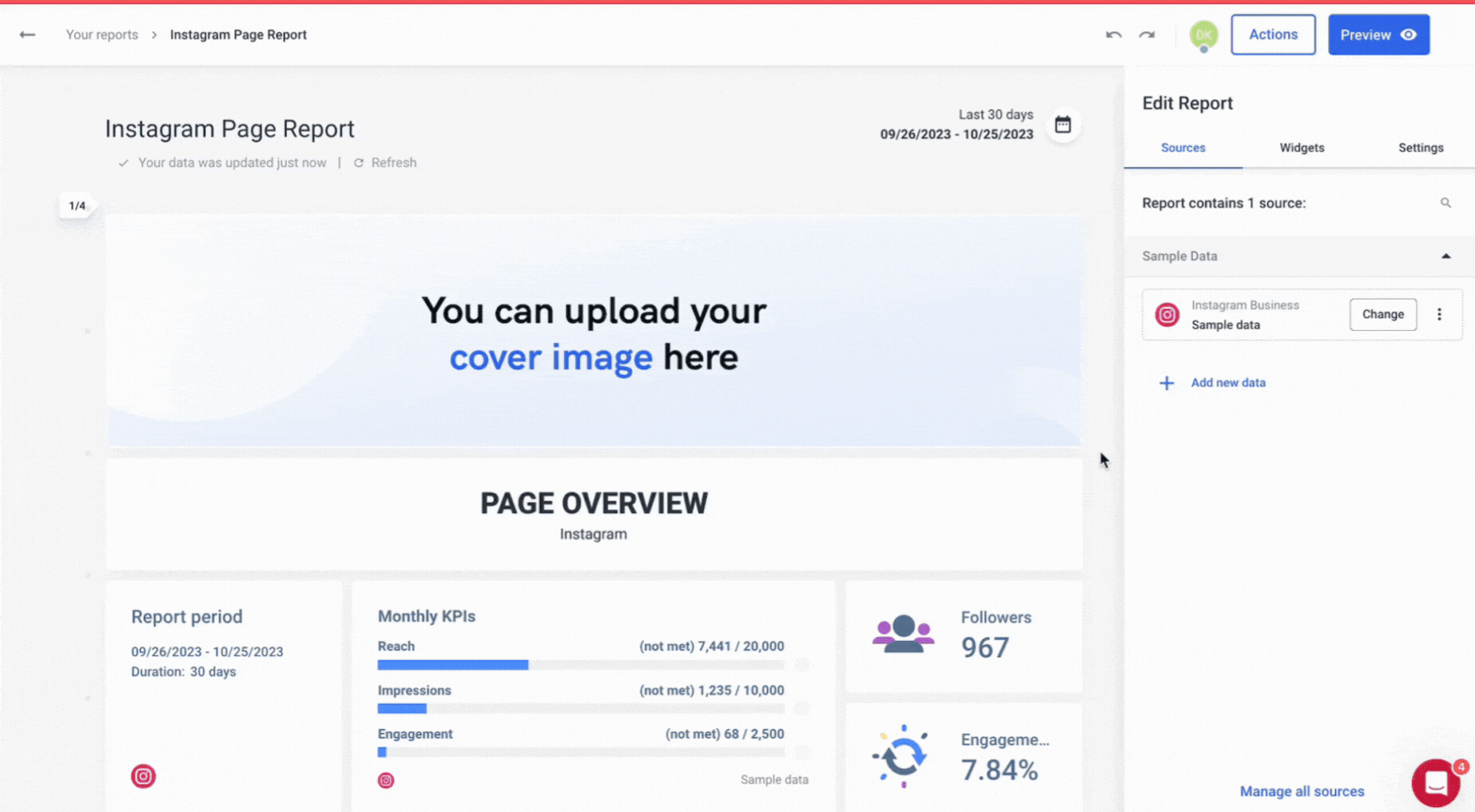
Whatagraph has everything you need to deliver polished, professional-looking reports every time. You can simply go to “Settings” and:
- Upload your logo or your client’s logo
- Create custom color schemes
- Add footer and header texts
- Create custom domains to host and share your reports
This video breaks down how white labelling works on Whatagraph:
And when you’ve customized and personalized your report, it’s ready for sharing with clients or stakeholders.
But how are you going to share it?
One client will ask for a live dashboard they can check every time, even on mobile.
Another will tell you they prefer static PDF reports they can file and present at monthly performance meetings.
On Whatagraph, you can easily set up both report-sharing options:
- Schedule PDF report sending: Once you finish a report, set up an email schedule by the client’s preferences.
- Share a link to a live report: Clients can access it at any time. They can change the date range to see how the performance has changed over time and hover over graphs to get more data from specific points.
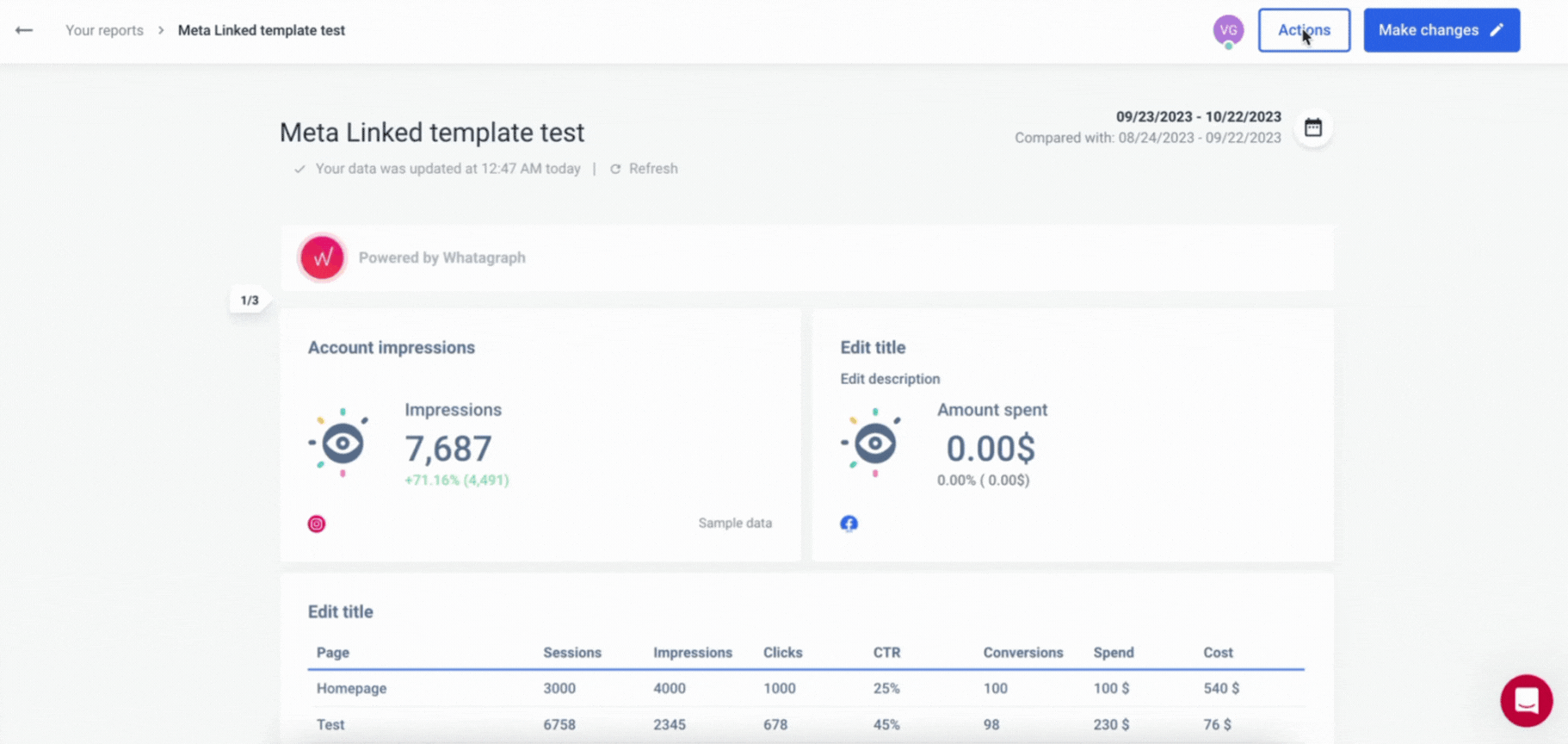
Set a data range, time of day, time zone, and you're done. The client will get a fresh report in their inbox at the same time every time.
Key features:
- 55+ native integrations
- Custom integrations through Custom API, Google Sheets, or BigQuery
- Versatile drag-and-drop widgets for reports and dashboards
- Custom metrics, dimensions, and data blends
- AI insights
- Currency conversions
- Library of pre-made dashboard and report templates
- Export to Excel and CSV
- Custom branding and white-label features
- Automated report sharing via email
- Links to live dashboards
- No-code data transfer to BigQuery and Looker Studio
Whatagraph reviews from real users
“To me, Whatagraph is like the Tesla or Mercedes of digital analytics tools, their clean and simple way to present complex marketing data. I highly recommend it to anyone working with marketing analytics who values efficiency and clarity in their reporting.” (Source)
“Whatagraph has a simple user interface that is easy to navigate even for those who don't have analytical skills.” (Source)
“What I like best about Whatagraph is having the ability to create reports fast and easy. No more spreadsheets to do reports, they have a great variety of templates.” (Source)
Pros:
- All-in-one marketing performance monitoring and reporting solution
- Easy to use by anyone on your team
- Fast campaign performance and insights
- Stunning visual reports
- Makes results easy to interpret
- Excellent live chat customer support
Cons:
- No freemium plan
- Can be expensive for small agencies (under 10 employees) and freelancers
Pricing
Whatagraph offers three pricing plans based on the amount of “source credits” and access to customization and data organization capabilities.
You can use source credits to connect data sources, send data from a source to a warehouse, and blend cross-channel data together.
Reach out to us for a custom pricing plan, just for you.
2. Klipfolio
Best for: Large data teams at companies and large agencies
Klipfolio is a data analytics and business intelligence platform in one. It offers two key products:
- PowerMetrics: Designed for data teams at large companies, this is a data analytics tool to centralize, standardize, and share accurate metrics throughout the organization. Non-data teams can then use these certified metrics for their dashboards and reporting needs.
- Klips: These are your regular data visualization dashboards and reports. Klips integrates 130+ platforms, and you can also use the Rest/URL option for custom integrations.
With PowerMetrics, you can bring all your data together in one place—and actually make sense of it.
Here’s how to do it:
- Create a curated metric catalog – Set up a library of key business metrics with access controls and governance, so the right teams see the right data.
- Run self-serve analysis with AI insights – No need to create reports—PowerMetrics helps you analyze data on your own.
- Store data where you want – Your metrics stay unified, whether you store the data in your data warehouse, semantic layer, or directly in PowerMetrics.
- Share insights easily – Once your data is transformed and unified, you can share key metrics across your organization—no manual work required.
These features help you put an end to endless data requests and bring data-driven decisions faster.
That is, of course, if you have a dedicated data team in the first place.
With PowerMetrics’ AI, interacting with your marketing data becomes as simple as asking a question.
Thanks to natural language processing (NLP), you can type in a query, and the system will automatically generate the visualizations you need.
Once you spot an important insight, you can save it to your dashboard for easy access and future analysis.
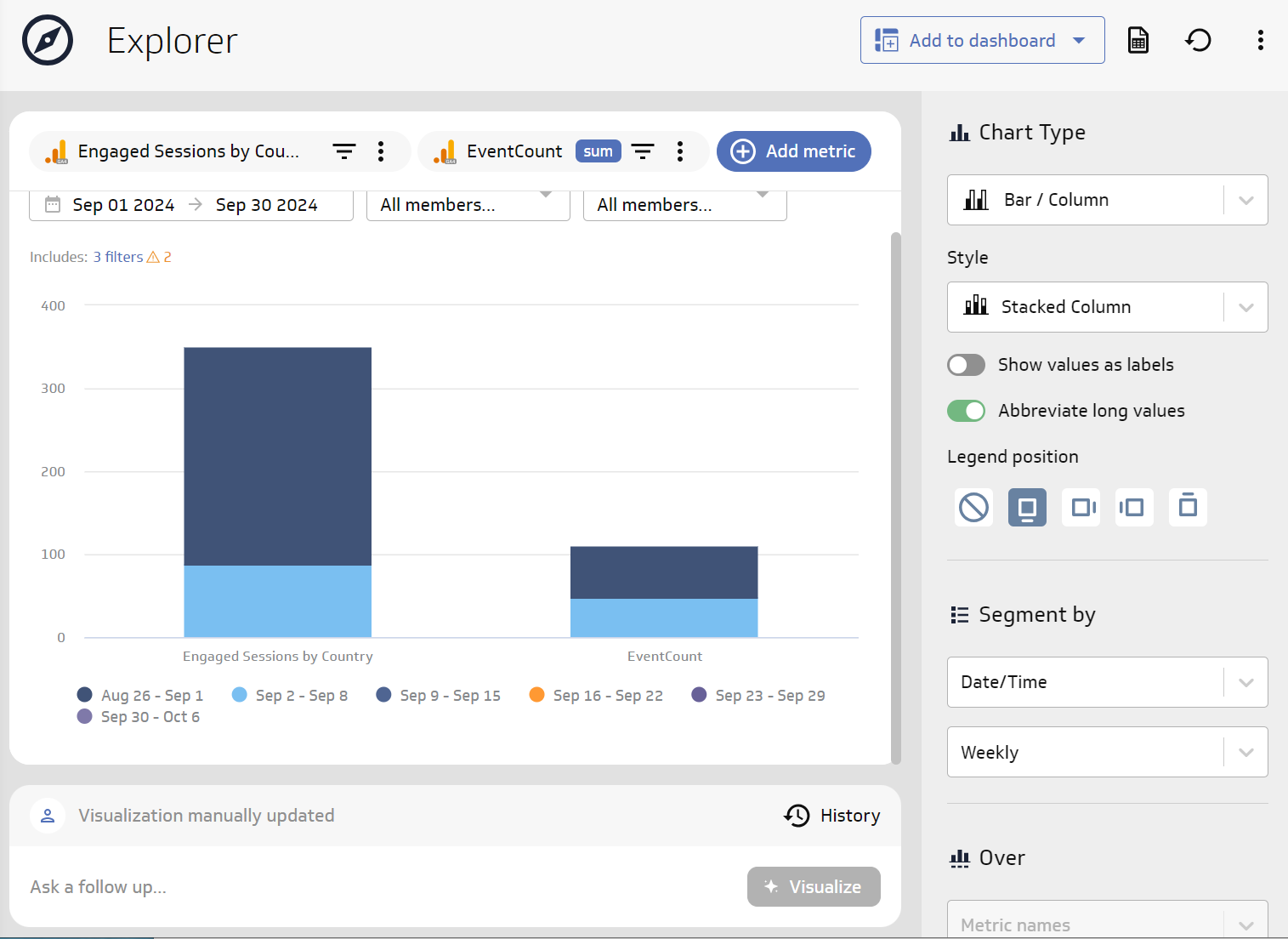
When you sign up for a Klipfolio trial, you immediately get access to your first dashboard—but here’s where things can get tricky.
To actually visualize your data, you’ll need to build a “Klip”, which is managed in a separate tab from the dashboard.
While there are some pre-made Klips, most of the time, you’ll be building them from scratch.
And that’s not always straightforward.
The custom Klip-building interface can feel clunky and confusing, even with an interactive tour to guide you.
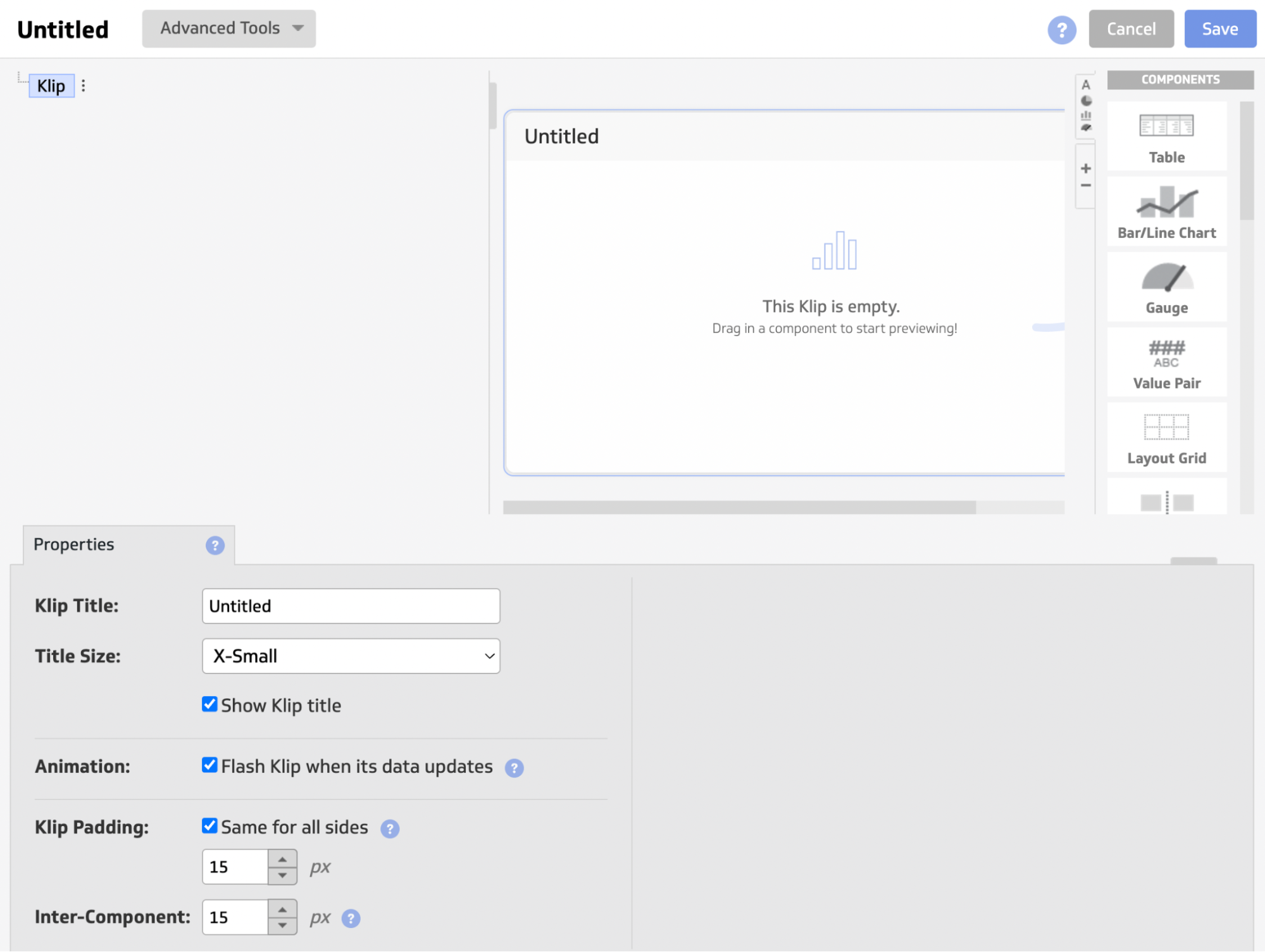
Depending on how complex your visualization is, expect to spend anywhere from 5 to 30 minutes just setting up a single Klip.
If you regularly report on complex business data in your organization and want a simpler, AI-driven approach, Klipfolio can be the right tool for you.
Key features:
- 130+ integrations, including warehouses, SQL databases, and file-sharing services
- Data blending, unifying, aggregating
- Custom metrics and dimensions
- AI insights
- Custom dashboards and reports
- Export dashboards as PDF or image files. Export only individual clips as CSV
- Scheduled reports
Klipfolio reviews from real users
“I needed something to convert Google sheets into dashboards to monitor our maintenance logs. Klipfolio is an incredibly intuitive quick solution.” (Source)
“The platform can run a little slow sometimes, particularly when performing complex actions. With Klips, data sources are always fully refreshed when loading up a dashboard, which can drag down the performance when working with multiple data sources at the same time.” (Source)
“I really dislike their training style. It's costly, and you have to pay a lot for a support ninja to help you. If you're a small company, it can run up your bill fast.” (Source)
Pros:
- Easy to use and set up
- Powerful data analytics and organization options
- AI insights to help make data-driven decisions
Cons:
- Expensive with important features only available as add-ons or in Enterprise plans
- Limited customization for dashboards and templates
- Unhelpful customer support
Pricing
Klipfolio offers three pricing plans for two of their products: PowerMetrics and Klips.
As of February 2025, here are the plans for PowerMetrics:
- 30-day free trial
- Professional: $300/month for 10 users and unlimited metrics.
- Enterprise: Custom pricing for 10 users, unlimited metrics, and priority support.
The Enterprise plan comes with data warehouse integration, AI insights, and custom domains, which are only available as add-ons on the Professional plan.
Klips’ pricing is further divided into plans for businesses and for agencies.
As of February 2025, here are the plans for businesses:
- Base — $90/month for 3 dashboards and 4 hr data refresh rate. No priority support or custom onboarding available.
- Grow — $190/month for 10 dashboards and 1 hr data refresh rate. No priority support or custom onboarding available.
- Team — $350/month for 20 dashboards and 15 min data refresh rate. No priority support or custom onboarding available.
- Team+ — $690/month for 60 dashboards and up to the minute data refresh rate. Includes priority support and custom onboarding.
Here are the plans for agencies:
- Agency Starter — $110/month for 5 dashboards, 5 clients, and 4 hr data refresh rate. No priority support or custom onboarding available.
- Agency Lite — $190/month for 15 dashboards, 15 clients, and 1 hr data refresh rate. No priority support or custom onboarding available.
- Agency Pro — $420/month for 30 dashboards, 30 clients, and 30-min data refresh rate. No custom onboarding available.
- Agency Premier — $1025/month for 80 dashboards, 80 clients, and 30-min data refresh rate.
3. NinjaCat
Best for: Marketing agencies and companies with dedicated data scientists
NinjaCat is an end-to-end platform for connecting to your data sources, cleaning the data, visualizing it, and shipping it to destinations.
You can connect data with 100+ pre-built integrations, including CRM, search engine advertising, web analytics, e-commerce, email marketing, and project management tools.
You can then simplify and harmonize your data with no-code transformations and custom calculations.
There’s also an option to store your data in a managed warehouse.
Alternatively, you can ship your data to external storage destinations like Snowflake, BigQuery, or Amazon S3 or business intelligence destinations like Tableau and Looker Studio.
As far as artificial intelligence options are concerned, NinjaCat comes with two features:
AI Agents: Designed to automate specific tasks, these AI assistants help you save time and optimize performance while digging out deeper insights from your data.
For example, the Campaign Performance Monitoring Agent monitors ad spend in real-time, alerting you to overspending and inefficiencies to protect your budget.
The Content Creation Agent assists in copywriting by analyzing ad copy and suggests improvements to boost engagement and conversion rates.
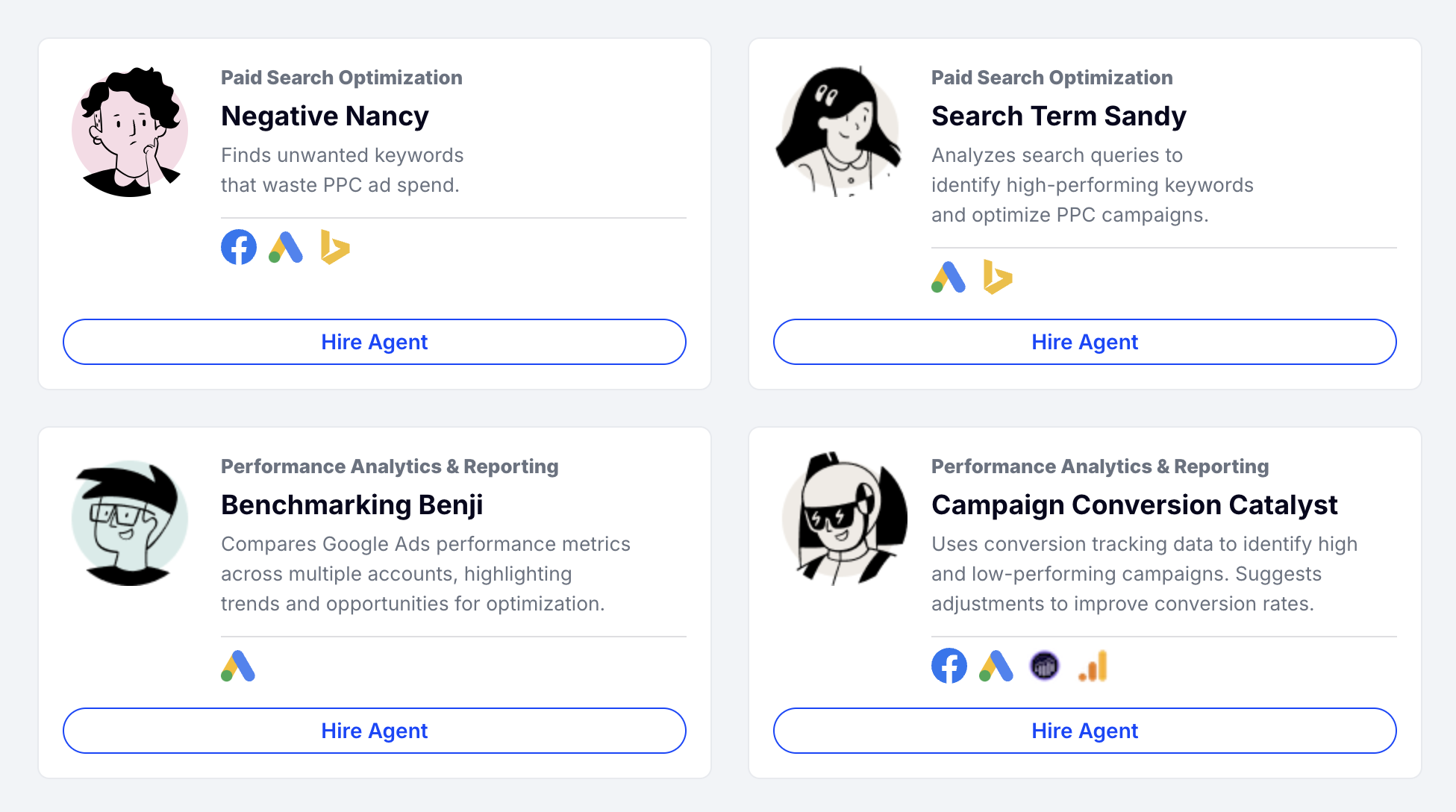
AI Insights Generator Widget: This is an AI summary widget you can link with a data widget in the template builder. It generates automated text about the connected data, depending on the prompt and language settings.
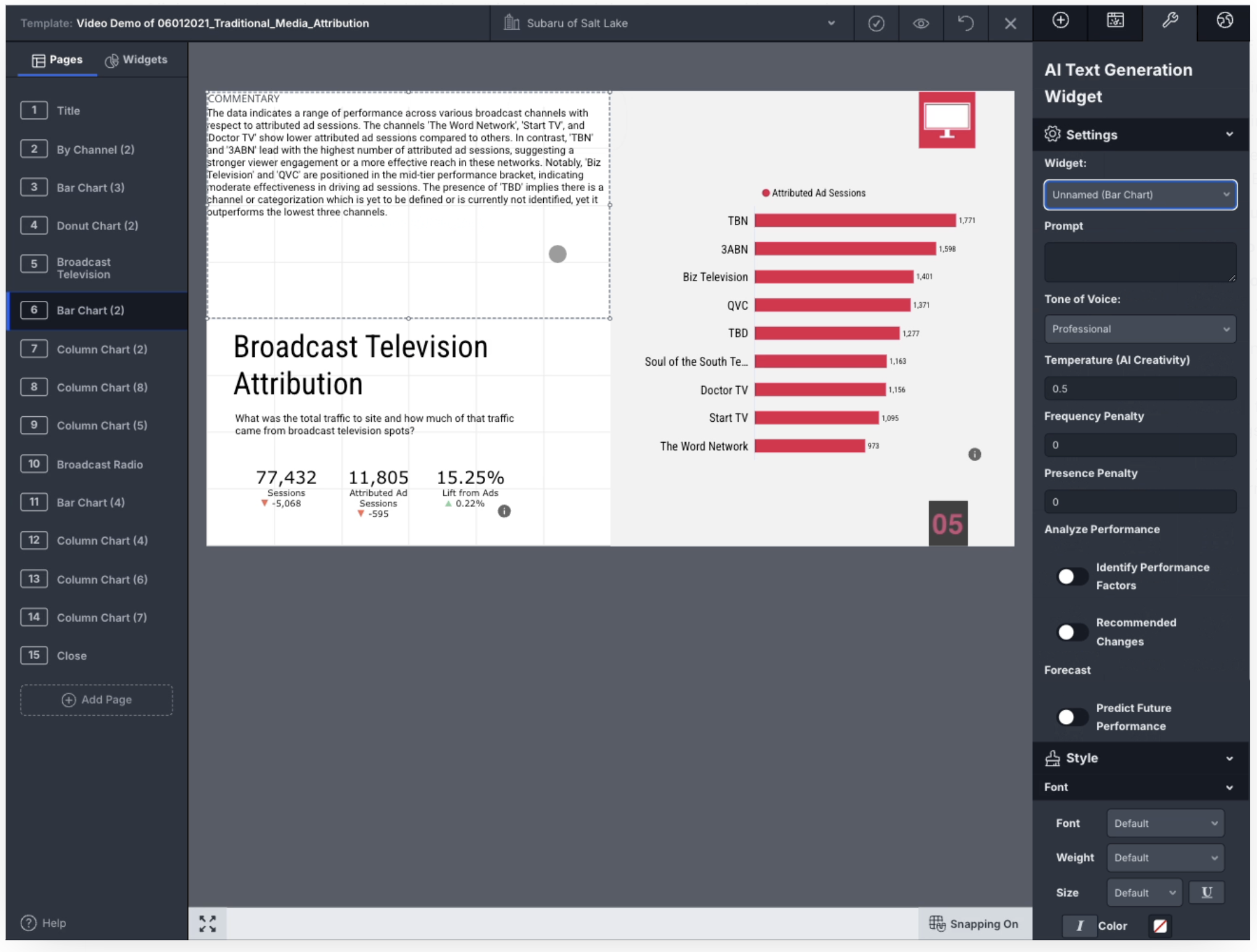
When it comes to creating reports, you can start from a blank template (that looks like a “canvas”) and add and adjust metric widgets as needed.
Key features:
- 100+ pre-built connectors
- No-code transformations and calculations
- Data transfer to BI tools and data warehouses
- Easy ad spend and campaign performance monitoring
- White-label options
- White-glove setup and service
NinjaCat reviews from real users
“NinjaCat helped us have a single pane of glass for all of our advertising channels in one place. Additionally, it has reduced the amount of time our team has had to put into our reporting decks.” (Source)
“NinjaCat can be finicky at times, so I struggle to use it as a live dashboard. I think it works stronger for me when I'm using a standard report during a set time frame that I can download.” (Source)
“When processing a large number of groups it can take a while. Users often run reports at the same time each month, however we are a large client with over a thousand reports that need run.” (Source)
Pros:
- Automated client reporting
- One platform for integration and visualization
- Multiple choice of destinations
- Custom branded reports
Cons:
- Separate workspaces to organize and visualize data
- Complex visualization builder
- Performance issues with reports
- No autosave in case of a crash
Pricing
NinjaCat doesn’t offer fixed pricing plans, and no information is available on its website.
Best AI Report Generators for Freelancers or Small Teams
These users want inexpensive AI-based reporting tools that can create quick, visually appealing reports, infographics, and presentations with minimal effort and without any design or data skills.
4. Venngage
Best for: Branded AI reports
Venngage is an online AI report builder that you can use to create a range of visual content types, including infographics, reports, presentations, and more.
Designed to be as versatile as possible, Venngage has a user-friendly design process that makes it a perfect report generator for non-designers.
It’s a handy tool for freelancers, educators, marketers, and businesses who want to improve their visual communications without hiring a graphic designer.
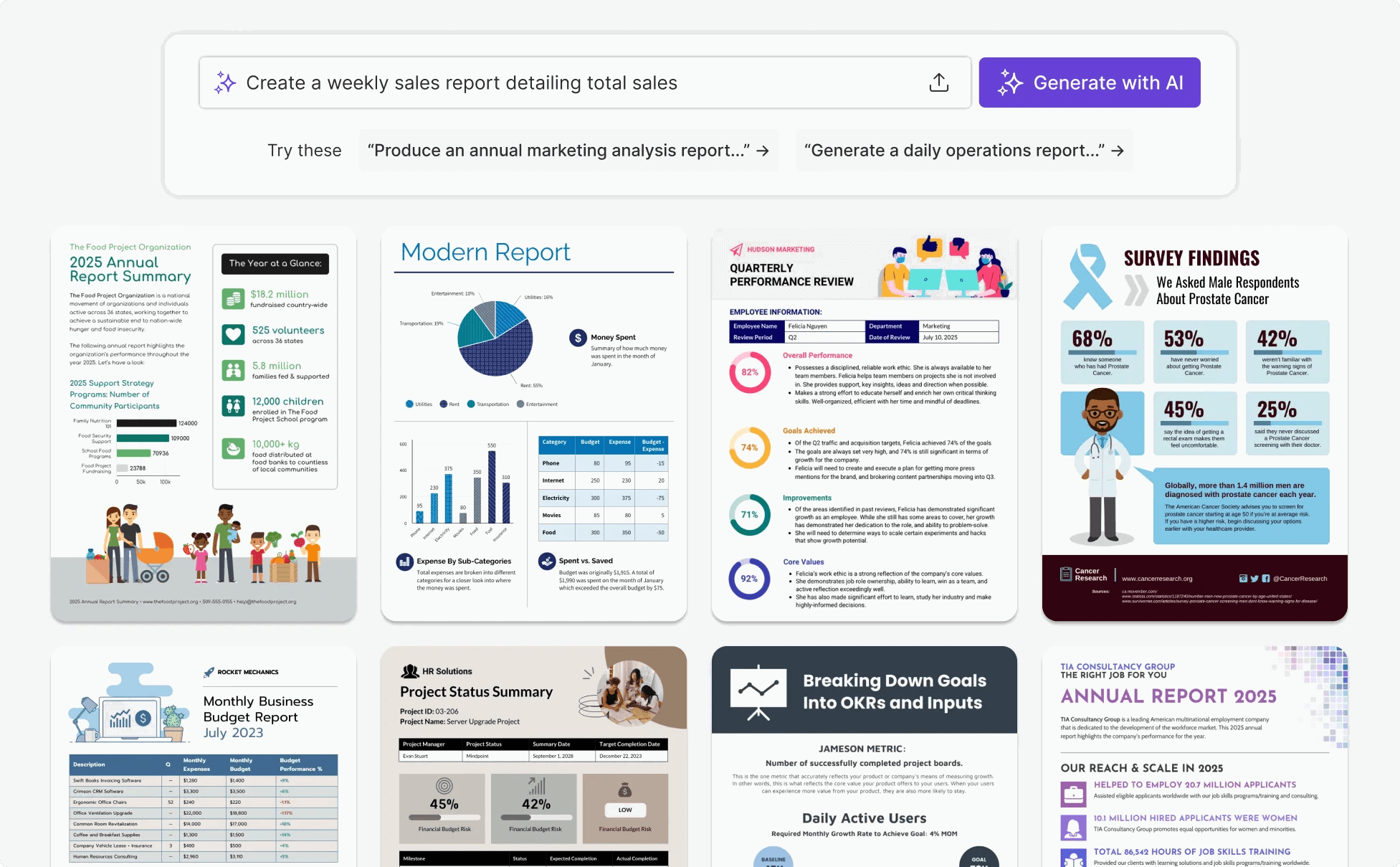
You can create a visualization from scratch or pick one of over 10,000 customizable templates.
To speed up the reporting process, Venngage offers several AI-driven features throughout the platforms:
AI Report Generator: Use simple prompts to quickly generate custom reports, infographics and presentations. The tool transforms written inputs and raw data into great looking branded visuals, saving you a ton of time on data analysis and design.
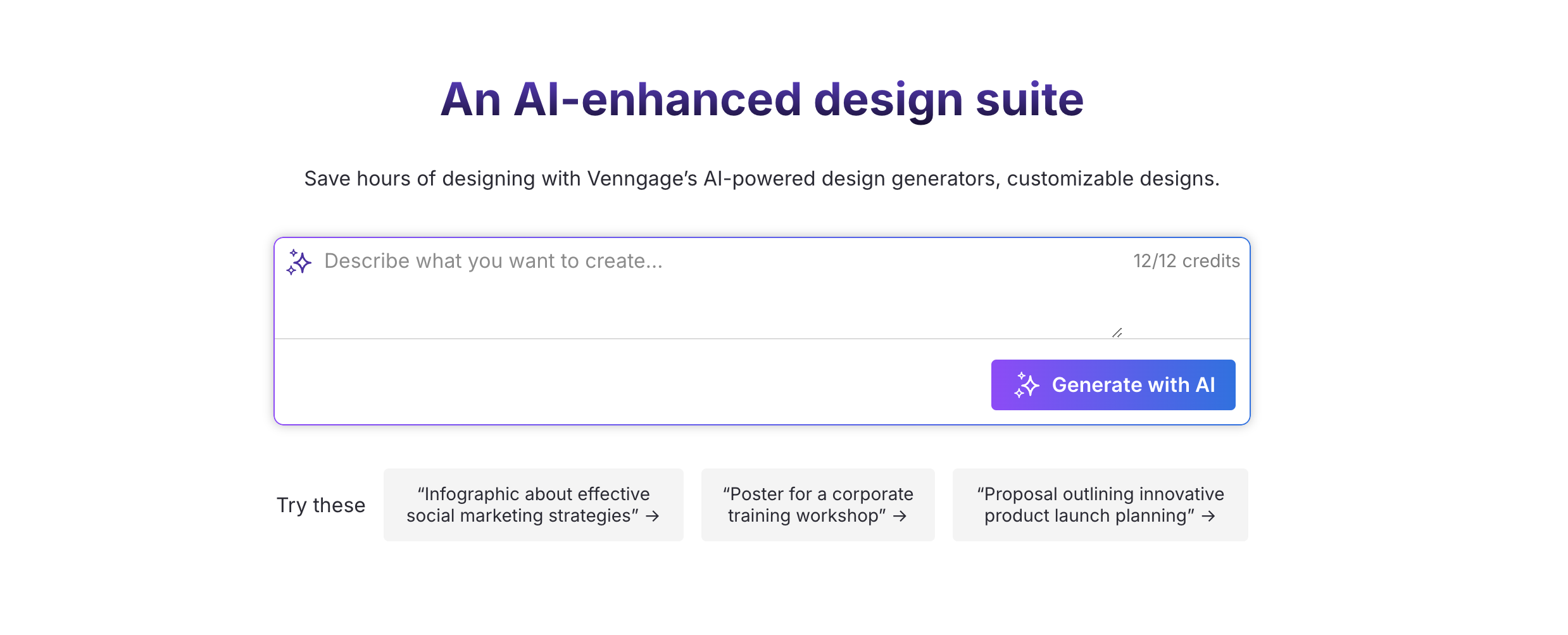
AutoBrand: AI can detect and extract brand colors, fonts, and styles directly from your website and apply them to your report or infographic in a few clicks. This way, you can keep your report visuals consistent across all projects and reports.
AI-assisted content generation: Venngage can also provide suggestions for compelling headlines, taglines, and marketing copy, as well as auto-generate image alt text for improved accessibility.
Key features:
- Large number of infographic, report, poster, brochure and other templates
- Full control over design elements
- AI-powered visual generator
- Real time collaboration features
- Branding extraction directly from a website
Venngage reviews from real users
“This program has SO many templates to choose from. I've been using it for almost two years, and I have yet not to find what I'm looking for.” (Source)
“Only 50 image uploads are allowed for premium users. If you want to upload more then, you need to upgrade.” (Source)
“The interactive UI of the platform makes it very easy for anyone to use this tool. With tons of templates and excellent graphics, Venngage clearly stands apart from its competitors.” (Source)
Pros:
- No design experience needed
- Time-saving
- Professional designs with minimal effort
Cons:
- Only public sharing is allowed with the free plan
- AI image generation on higher-end plans only
Pricing
As of February 2025, Venngage offers 4 pricing plans:
- Free —Up to 5 designs and 6 image uploads, free widgets and icons, and public sharing.
- Premium — $10/month/user for unlimited designs, Hi-Res PNG, 50 image uploads and private sharing. Email and chat support.
- Business — $24/month/user for AutoBrand kit, team sharing, business icons and templates, 1000 image uploads, and PDF and PowerPoint export. Priority email and chat support.
- Custom pricing — for teams 11-100+, dedicated account manager, live onboarding. Custom APIs and integrations.
5. Piktochart
Best for: Project managers and small businesses who need all-in-one visual communication tools.
Piktochart AI reporting software uses advanced artificial intelligence to generate professional-looking reports in seconds. With just a single prompt, you can generate a report that’s auto-populated with templates from their library.
Once you’re happy with your report, you can customize it in different ways. You can change color palettes, add or remove icons, or rearrange the elements with a simple drag-and-drop.
At the first glance, Piktochart and Venngage are very similar AI tools for reporting. They have a super user-friendly interface and a ton of templates, and both offer collaboration options.
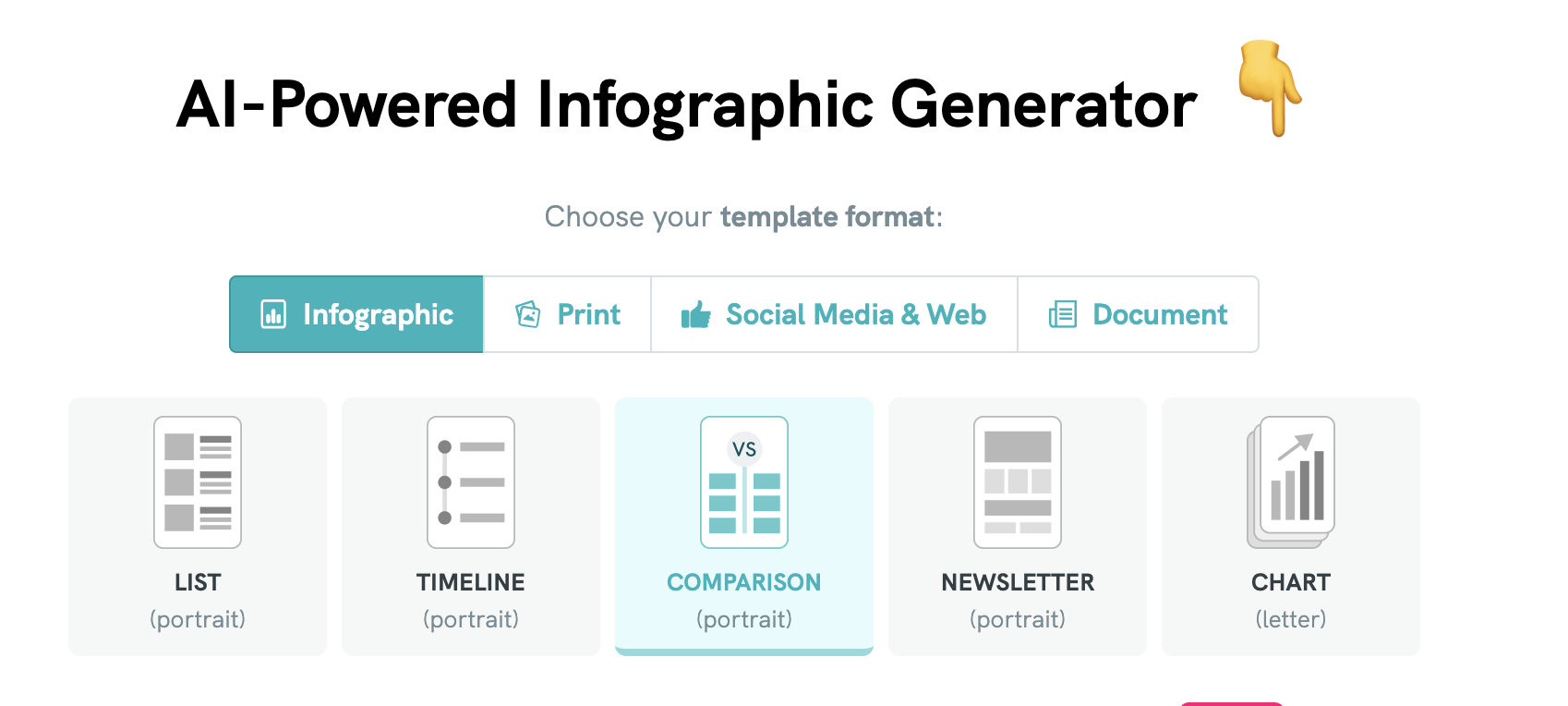
However, there are a few key differences that can help you take your pick.
Venngage offers much more templates with a strong focus on infographics and reports. Piktochart has fewer infographic templates but offers additional formats like presentation and social media graphics, in addition to reports.
This makes Piktochart a more versatile tool for small businesses.
Piktochart offers brand customization, but Venngage wins here with its My Brand Kit, which can capture the branding elements from any site.
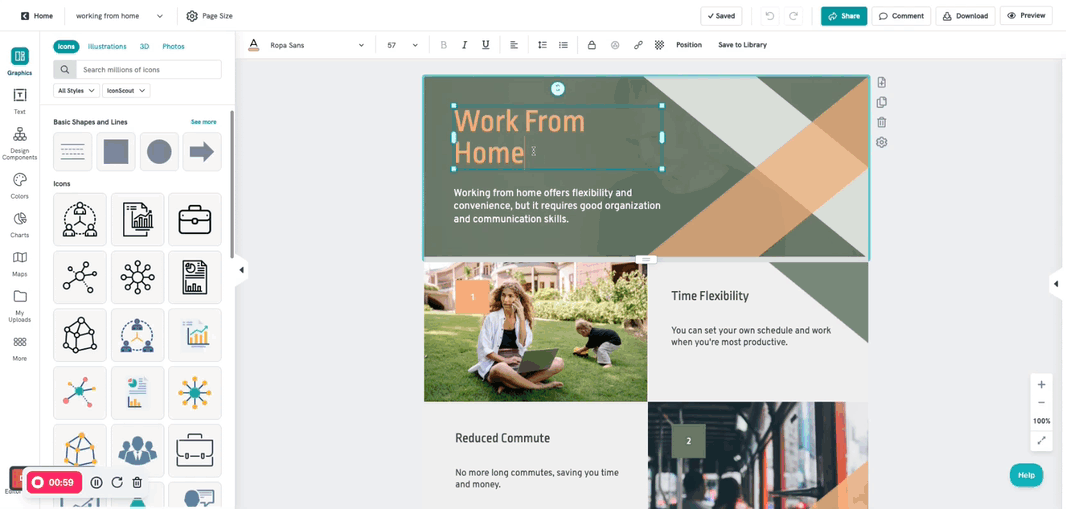
On the other hand, Piktochart offers more generous image storage — 100GB in its Pro plan, compared to Venngage’s limit of 500 uploads in the Business plan.
Key features:
- Customizable templates
- Drag-and-drop report editor
- AI visualization
- Large library of icons, illustrations and other design elements
Piktochart reviews from real users
“Piktochart gives the impression that I have formal training in graphic design even when I don't. It's challenging to make something ugly in this program.” (Source)
“Could expand their charts & graphics library. Their maps tool for instance is basic and would require a third party map maker to make the visuals.” (Source)
“The best about Piktochart I like is that it contains a lot of pre-built graphics layouts, which we can use for creating our graphics design for using those on various platforms, all the templates that Piktochart provides is easy to alter and modify.” (Source)
Pros:
- Simple and easy to use
- Multiple content formats
- Teamwork features
- AI-powered tools
Cons:
- Limited free plan
- Not many unique templates
Pricing
Piktochart offers 3 pricing tiers:
- For Individuals & Businesses
- For Teachers & Students — requires a valid educational email address.
- For Nonprofits
Each tier has its own pricing options. As of February 2025, the pricing for individuals & businesses looks like this:
- Free — $0/month for 2 PNG downloads, unlimited visual projects, 50 AI credits, all templates and formats, and 100MB storage
- Pro — $14/member/month for unlimited PNG downloads, 5M+ premium icons, illustrations & 3D graphics, 1000 AI credits, 100GB storage
- Business — $24/member/month for unlimited PNG, PDF, PPT downloads, unlimited brand colors schemes, custom fonts, logos, 3000 AI credits, 250GB storage
- Enterprise — Custom pricing for everything Business plan plus dedicated account manager and training, custom on-demand templates, 1TB storage, and custom subdomain.
6. Easy-Peasy.AI
Best for: Creating simple reports quickly
Easy-Peasy.AI is an all-in-one AI content creation platform that you can use to create diverse content types including project reports.
Besides AI generated reports, the platform offers over 200 templates for blog posts, social media content, emails, and even job descriptions.
Easy-Peasy.AI uses advanced AI models such as ChatGPT-4 and Claude to power tools for:
- AI-assisted content generation: Use templates to create different content types, from long-form articles to social media posts.
- AI image generation: Transform textual descriptions into unique visuals to make your reports and presentations more engaging.
- Text-to-Speech: Convert audio files into text and vice versa, with support for over 40 languages.
- Custom AI chatbots: Build and deploy AI-driven chatbots for websites or messaging platforms without coding expertise.
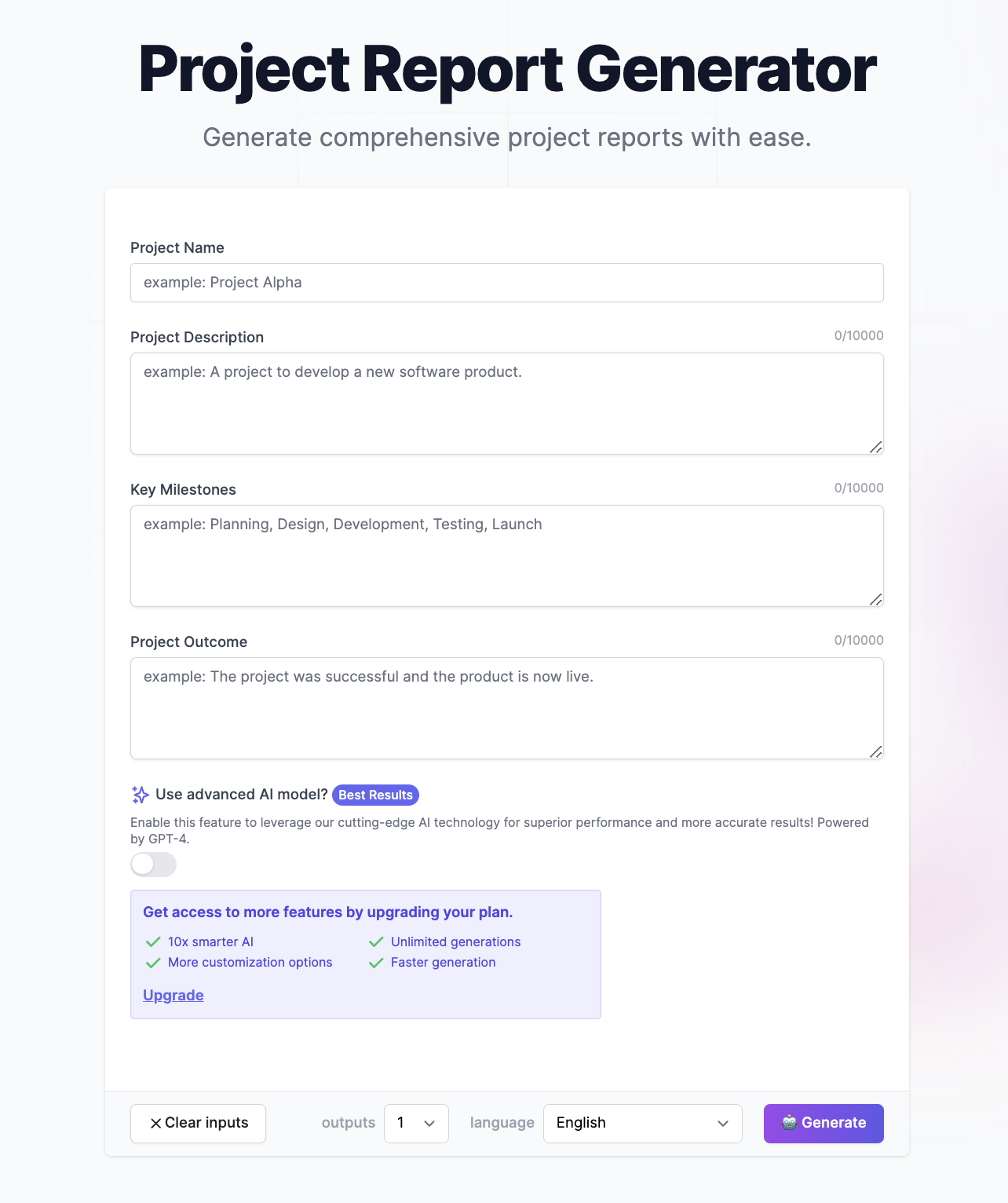
Key features:
- Quick AI reports using simple prompts
- Pre-built templates for different report types
- Clear and concise non-AI-like language
- Team collaboration
Easy-Peasy.AI reviews from real users
“What I appreciate most is how much time it saves me. Instead of spending hours brainstorming, I can focus on refining and personalizing the suggestions it provides. Also multiple AI selections are really useful!” (Source)
“The intuitive interface without needing any technical expertise. Use runs fast and the results are highly accurate. Plus, the affordable pricing plans make powerful AI accessible even for individuals and small businesses.” (Source)
“It has limited customization options may be a drawback for users seeking more fine-grained control over their tasks and workflows.” (Source)
Pros:
- AI image and video generator
- Competitive pricing
- Wide range of template use cases
- Multilingual support
Cons:
- Design customizations are limited compared to competitors
- Best for straightforward reports, with no support for complex designs
Pricing
Easy-Peasy.AI has usage-based pricing with 4 plans.
As of February 2025, their pricing goes like this:
- Free — $0/month for 1,000 words, 1 image credit, 1 audio description, 1 bot, and 170+ templates.
- Starter — $8/month for unlimited GPT-4o mini, 25,000 GPT-r or 50,000 GPT-4o words, 150 image credits, 2 bots, 3 brand voices.
- Unlimited 50 —$12/month for unlimited GPT-4o mini, 50,000 GPT-4 or 100,000 GPT-4o words, 250 image credits, 30 audio transcriptions, 3 bots, unlimited brand voices
- Unlimited — $16.5 for unlimited GPT-4o mini, 100,000 GPT-4 or 200,000 GPT-4o words, 350 image credits, unlimited audio transcription, 4 bots, 35+ languages, API access, priority support
Best AI Reporting Tools for Enterprises
Enterprise users want advanced AI reporting tools that offer deep data analysis, predictive insights, and real-time visualizations that drive intelligent business decisions. These tools come with automated data processing models and AI recommendations to optimize performance across an organization.
7. Tableau
Best for: Data teams at large enterprises
Tableau is a capable business intelligence tool that comes with an intuitive drag-and-drop interface you can use to quickly generate insights and share them as reports with stakeholders.
It supports advanced calculations, data blending, statistical functions, and predictive modeling.
You can analyze complex data in different ways to uncover trends and identify opportunities for optimization using trend lines, forecasting, and clustering.
Tableau offers two artificial intelligence features:
Tableau Agent: It uses conversational AI to help you speed up every stage of data analysis, from cleaning to explorations.
For example, you can describe a calculation in the dialog box, and Tableau Agent will give you a calculation you can apply to your data.
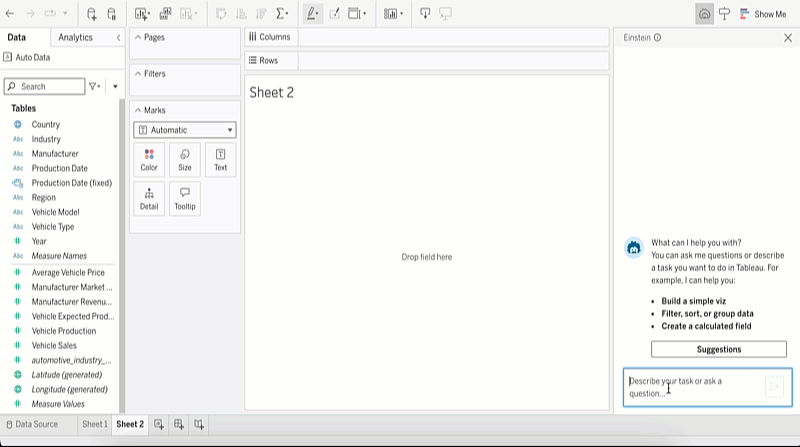
You can also transform prompts into visualizations, edit formulas, and drag-and-drop visualizations for your report.
Tableau Pulse: This is a data experience tool that you can use to discover intelligent, personalized, and contextual insights from your data. It’s designed to help every team in the organization integrate data into their flows to make faster, better-informed decisions.
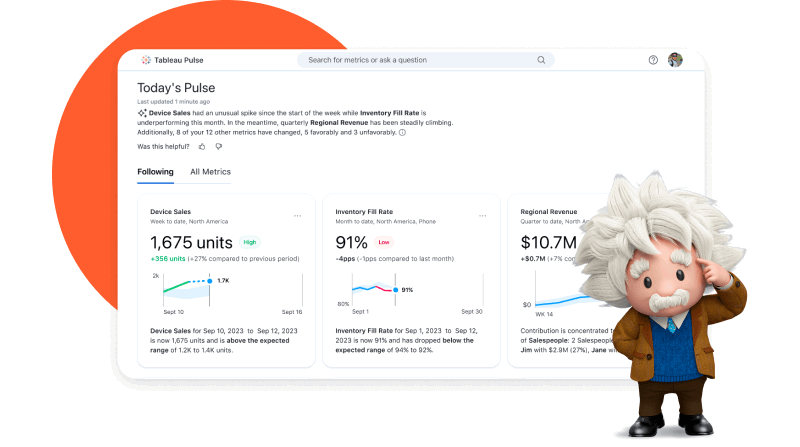 It can automatically detect drivers, trends, contributors and outliers for the metrics that matter to you. It flags changes in data using natural language, supported with visual explanations.
It can automatically detect drivers, trends, contributors and outliers for the metrics that matter to you. It flags changes in data using natural language, supported with visual explanations.
If you have no prior experience with Tableau, you can purchase “Success Plans” that include personalized support and training.
In addition, Tableau is known for a large and active user community called “Tableau Community Forums”, which is a treasure trove of resources, forums, and online training materials.
Still, keep in mind that Tableau is an enterprise-grade tool that doesn’t come cheap either.
Key features:
- 90+ integrations
- Custom metrics and dimensions
- Data blending
- Drag-and-drop dashboard interface
- AI-powered insights
Tableau reviews from real users
“My favorite aspect of Tableau is that it forces me to track my performance by metrics in a more straightforward way. These interactive dashboards let me see my performance at a glance, and identify trends or areas where I need to improve.” (Source)
“The drag-and-drop interface of Tableau is user-friendly especially for individuals lacking extensive technical knowledge.” (Source)
“Tableau can be costly, particularly for startups. Even with its flexibility, the licensing model still adds costly, especially when you extend usage across teams or a complete company.” (Source)
Pros
- Powerful data analytics and visualization
- Easy to use and implement
- Seamless data integrations
Cons
- Can be expensive if you need advanced features
- Takes a lot of time to load for large datasets
- All the preprocessing of the data (data cleaning) has to be done beforehand. Data cleaning cannot be done in Tableau
Pricing
As of February 2025, Tableau offers three pricing plans:
- Viewer — $35/user/month, billed annually
- Explorer — $70/user/month, billed annually
- Creator — $115/user/month, billed annually
8. Power BI
Best for: Business analysts in SMBs
Microsoft Power BI is a business intelligence software suite that includes apps, services, and data connectors. It’s a cloud-based dashboard tool that you can use to combine data from multiple sources into a single data set.
Power BI, on the other hand, creates engaging visualizations, including interactive charts, graphs, maps, and custom visuals from the Power BI community.
Power BI comes with the Insights features that use artificial intelligence. You can use it to create:
- Insights for individual visuals
- Insights for dashboard tiles
- Quick Insights for datasets — without creating reports.
- AI Insights for data models in — pre-trained machine learning models provided by Azure Cognitive Services
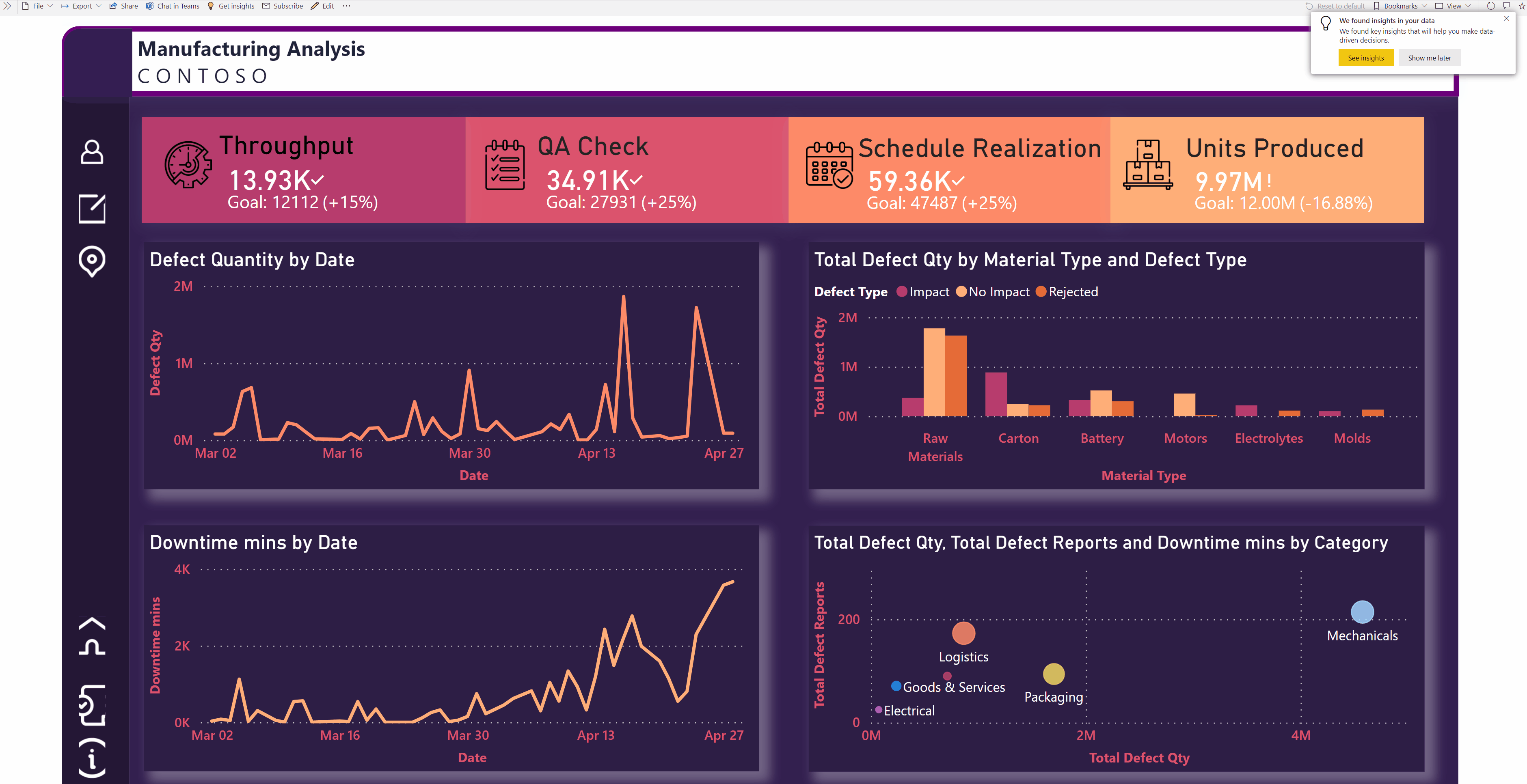
Power BI has been one of pioneers of integrating AI into business software. Among other Power BI AI features, the most useful are Key Influencers, Decomposition Tree, Natural Language Query, Anomaly Detection, Sentiment Analysis, and Forecasting.
- Natural Language Query (NLQ): You can use it to instantly match the words you type with relevant database information, which returns quick results. This feature is supported by AI and machine learning models which help non-technical users analyze and explore their data.
- Anomaly Detection: It helps you to automatically detect irregularities in time series data with customized settings. Besides identifying spikes and dips in the data, you can access explanations through the insights pane.
- Key Influencers: This AI visual algorithm helps you analyze data, classify the factors, and display them as key influencers. You can use it to get insights from data by analyzing the relationships between a number of variables and identifying which one is associated with a specific outcome.
- Decomposition Tree: This is a new AI feature in BI visualization that you can use to break down data on multiple analysis dimensions to find root causes, trends, and patterns faster. It’s best used when the data is settled at different levels, so you must put it in a particular hierarchy, or when you need to drill into data fields.
- Sentiment Analysis: You can use it to understand a task’s importance or urgency, and estimate a group’s or individual interest in something. This AI feature uses natural language processing to determine the polarity of the opinion and also extract emotions attached to it.
- Forecasting with AI: it can show you important trends and insights into time-series, real-time, and cross-sourced data and identify tendencies, correlations, and patterns that can impact the business outcome. Predictive analytics is essential in analyzing historical data and studying buying behavior.
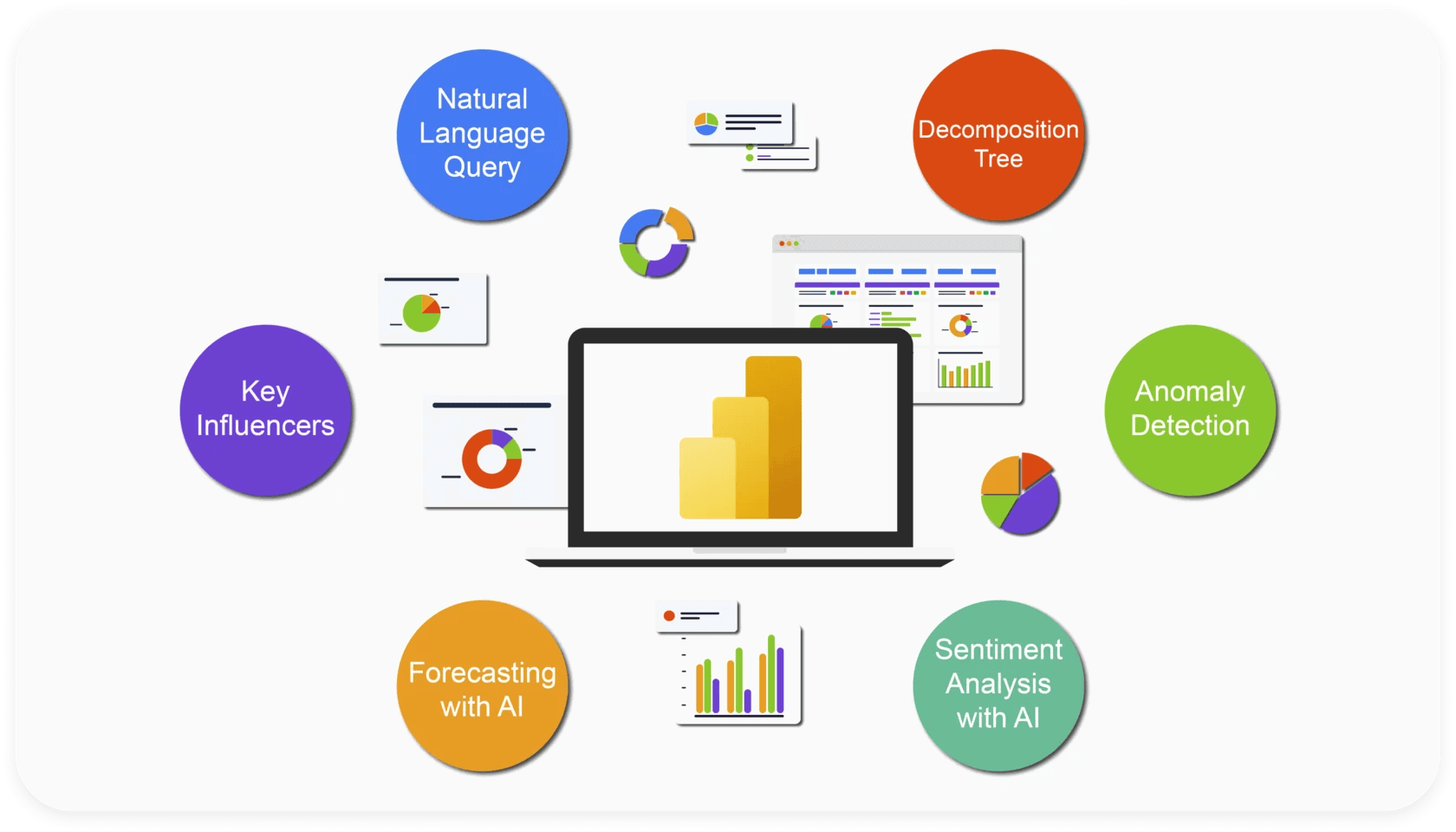
Power BI is highly scalable and can handle large volumes of data and complex analytics workloads.
You can connect various data sources, including Microsoft products (such as Dynamics 365 and Azure), databases (SQL Server, Oracle, MySQL, etc.), cloud services (Google Analytics, Salesforce, etc.), and many others.
On the other hand, direct integrations are limited to 59 apps, and most users notice that Power BI works best with other Microsoft platforms such as Microsoft Edge and Office 365.
Key features:
- 100+ integrations
- AI-powered insights and “Co-pilot”
- Data transformation and unification
- Native visualization dashboard and reports
- Shareable reports with other Microsoft services, including Teams, PowerPoint, Excel, and Power Platform
Power BI reviews from real users
“For anyone already used to the Microsoft ecosystem, PowerBI delivers a combination of a user-friendly interface and powerful analytics.” (Source)
“Power bi has a eye catchy user interface and tons of customizing options.” (Source)
“The DAX (Data Analysis Expressions) which is used to creating complex calculations in Power Bi need a deep learning curve for the new users.” (Source)
Pros:
- Advanced AI features
- Wide choice of integrations
- Advanced data visualization options
- Real-time processing
Cons:
- Steep learning curve
- Needs additional configurations to connect non-Microsoft sources
- Creating complex reports requires technical knowledge
Pricing
Power BI offers three pricing plans:
- Pro: $10/user/month
- Premium: $20/user/month
- Power BI in Microsoft Fabric: Custom pricing
9. Domo
Best for: Data teams and tech-savvy marketing teams
Domo is a cloud-based business intelligence platform that you can use to connect and prepare data, automate reporting, and deliver fast insights that fuel data-driven decisions.
If you’re skilled enough, you can use Domo to create business apps and dashboards or build data experiences that integrate real-time data from any source.
You can ask Domo AI Chat questions about your data and get suggestions for next steps or call on other AI Agents to create a calculated field, build a dashboard or app, and more.

AI Chat is context-aware, which means it will base the answers on the DataSets and cards hosted either by an App Studio app or by the dashboard you’re currently viewing.
After getting the answer, you can access a detailed breakdown of each step, with an AI Chat suggesting additional questions to help you go deeper.
AI Chat also stores chats from past sessions, so you can view them in the chat history.
These features make Domo a one-stop data experience solution for executives in departments ranging from sales and finance to marketing to engineering and HR.
Domo comes with native data visualization, embedded analytics, and self-service reporting supported by over 1,000 data connectors.
Key features:
- Data and workflow apps - pre-built, low-code, or full-code
- Drag-and-drop report and dashboard builder
- 1,000 on-premise and cloud connectors
- Data transformation and ETL
- Embedded analytics
- Mobile app
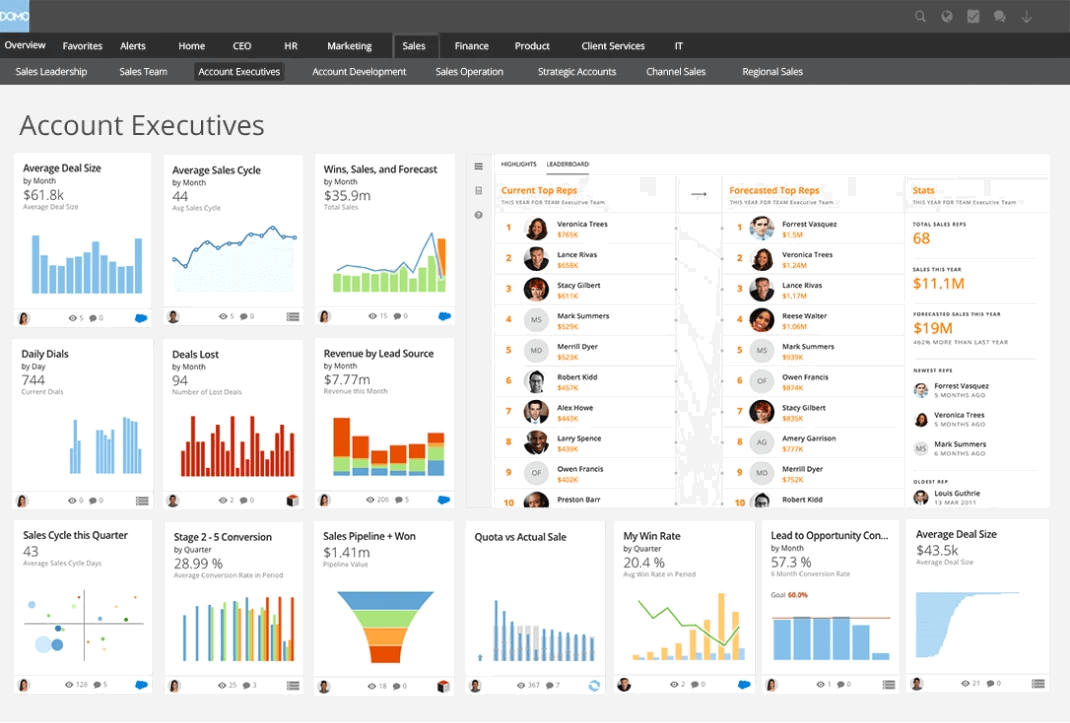
Domo reviews from real users
“Domo provides options that cater to all data proficiency levels across the product offering, typically a pro full code level, code-less drag and drop function gui, and no code option for novices or very simple tasks.” (Source)
“You won't see much of the themes and creative visuals here. Only limited themes are there which can make almost all the dashboards/apps look similar.” (Source)
“Products have become more buggy since the introduction of app studio in April of 2024. Training is good for the core product but it is difficult to find education on new products/tools.” (Source)
Pros:
- Easy-to-use interface
- Real-time data access
- Wide choice of visualizations
- Large number of connectors
- Mobile access
Cons:
- Steep learning curve despite user-friendly user interface
- It might require some SQL knowledge
- Performance issues with large datasets
- Costly additional features
- Limited report scheduling options
- Potential downtime issues due to cloud-based infrastructure
Pricing
Domo has a free 30-day trial and three pricing plans, but pricing is not publicly available. You have to ask their sales team for a quote. The pricing is based on the overall usage of the platform and factors such as data storage, data refresh rates, the number of users, the volume of data queries, etc.
FAQs
What is an AI marketing report generator?
An AI marketing report generator is a tool that you can use to create marketing reports by analyzing data from multiple sources and transforming it into clear, actionable insights. By analyzing natural language questions, these tools can generate customized reports with visualizations and actionable summaries.
Can AI marketing report-writing tools replace human analysts?
While AI marketing report writing tools streamline reporting and automate insights, they work best alongside human marketing experts. They help marketers focus on strategy rather than time-consuming manual data tasks.

WRITTEN BY
Nikola GemesNikola is a content marketer at Whatagraph with extensive writing experience in SaaS and tech niches. With a background in content management apps and composable architectures, it's his job to educate readers about the latest developments in the world of marketing data, data warehousing, headless architectures, and federated content platforms.